Colonial architecture in Jakarta

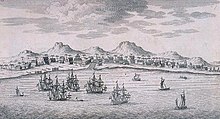
Colonial buildings and structures in Jakarta include those that were constructed during the Dutch colonial period of Indonesia. The period (and the subsequent style) succeeded the earlier period when Jakarta (known then as Jayakarta/Jacatra), governed by the Sultanate of Banten, were completely eradicated and replaced with a walled city of Batavia.[1] The dominant styles of the colonial period can be divided into three periods: the Dutch Golden Age (17th to late 18th century), the transitional style period (late 18th century – 19th century), and Dutch modernism (20th century). Dutch colonial architecture in Jakarta is apparent in buildings such as houses or villas, churches, civic buildings, and offices, mostly concentrated in the administrative city of Central Jakarta and West Jakarta.
Below is a list of colonial buildings and structures found in Jakarta. The list is sorted alphabetically according to its official (local) name. The list can also be sorted to each category.
Buildings that were renovated in a manner that significantly changed their appearance are listed separately to distinguish the different architectural form.
Some notable Chinese-style buildings and Islamic mosques that were built during these period are included in the list for comparison.
Dutch East India Company period – 17th to late 18th century
[edit]
The first type of colonial architecture grew from the early Dutch settlements in the 17th century when settlements were generally within walled defenses to protect them from attack by other European trade rivals and native revolt. Following the siege of Jayakarta (previously known as Sunda Kelapa) and its demolition by the Dutch in 1619, it was decided to build the headquarters of the Dutch East India Company on the site. Simon Stevin was commissioned to design a plan for the future settlement based on his concept of the 'ideal city'. His response was a rectangular, walled town, bisected by the river Ciliwung which was to be channeled into a straight canal (later known as also known as Grote Rivier or Kali Besar or "Big River" in this area). This new city is called Batavia (now Jakarta). In accordance with Stevin's model, the fortress of Batavia was the most prominent building in the city, symbolizing the center of power, while townhall, markets, and other public buildings were distributed. This layout of Jakarta can still be clearly recognized today in Jakarta Old Town through the layout of the streets and canals, although most of the original 17th-century structures had been destroyed or replaced with newer early 20th-century structures.[2]
The architecture style of this period was the tropical counterparts of 17th-century Dutch architecture. Typical features include the typically Dutch high sash windows with split shutters,[2] gable roofs,[2] and white-coral painted wall (as opposed to exposed brick architecture in the Netherlands). This earlier period of Jakarta had many of the buildings solidly built with relatively enclosed structures, a structure that is not very friendly to tropical climate as compared to the architecture of the next period in Jakarta.[2] The best examples of these types of buildings were located along the Tygersgracht (now Jalan Muka Timur) and all of them were demolished.[2] The best surviving example is Toko Merah.
Several types of Portuguese colonial architecture also exist, usually outside the walled city of Batavia. Tugu Church and Sion Church, with their plain facades and domed windows, are some surviving examples.
In 1808, Daendels officially moved the city center to the south because of the deteriorating condition of the inner town as well as the malaria outbreak. As a result, many buildings and structures from this period were left to deteriorate. Because of financial issues, many buildings were demolished in the 19th century and the debris was used to construct newer structure in the south, such as the Palace of Governor-General Daendels (now the Financial Department of Indonesia) from the debris of Batavia Castle, and Batavia Theater (now Gedung Kesenian Jakarta) from the debris of the Spinhuis.
Later, these empty lots in Jakarta Old Town were filled with newer 20th-century structures. Surviving 17th–18th structures were later converted as Jakarta's cultural heritage, e.g. Toko Merah, Gereja Sion and Jakarta History Museum.
Other dominant architecture styles from this period were the Chinese merchant houses, many were built during the 18th century. Many of these structures show an eclectic mix of Dutch and Chinese influences.[2]
| Last official name | Former names | Year | Architect | Location | Latest image | Oldest image |
|---|---|---|---|---|---|---|
| 18th-century Dutch mansion at Kali Besar Barat | Bank of China, formerly Firma Tels & Co[3] | 18th century | anonymous | 6°08′11″S 106°48′41″E / 6.136367°S 106.811372°E |  |  |
| Arsip Nasional | Reynier de Klerck house[4] | 1760 | Reynier de Klerck | 6°09′14″S 106°49′01″E / 6.153761°S 106.817036°E |  |  |
| Baijen's Country House and the Outer Hospital (demolished, replaced by Citadel Prins Frederik) | Baijen's Country House and the Buiten-hospital[5] | before 1669, later a hospital, from 1743 until 1820.[5] | anonymous | 6°10′13″S 106°49′51″E / 6.170386°S 106.830742°E | ||
| Bastion Amsterdam (demolished) | Amsterdam | 1632–1635[6] | anonymous | 6°07′46″S 106°48′54″E / 6.129527°S 106.815078°E | — |  |
| Bastion Buren (demolished) | Buren | before 1650[7] | anonymous | 6°07′41″S 106°48′28″E / 6.128014°S 106.807904°E | — | |
| Bastion Cuylenburg (demolished, on its site stands Menara Syahbandar) | Cuylenburg, Cullenburch, Culemborg[8] | 1645[3][7][9] | anonymous | 6°07′39″S 106°48′33″E / 6.127527°S 106.809071°E |  | |
| Bastion Diest and gate (demolished) | Diest, Diestpoort | 1632–1635 (bastion),[6] 1638 (gate),[10] 1657 (gate strengthened with stone)[10] | anonymous | 6°08′12″S 106°48′42″E / 6.136733°S 106.811704°E |  |  |
| Bastion Enkhuizen (demolished) | Enkhuizen | 1627–1632[6] | anonymous | 6°08′05″S 106°48′59″E / 6.134680°S 106.816474°E |  |  |
| Bastion Friesland (demolished) | Friesland | 1632–1635[7] | anonymous | 6°07′55″S 106°48′22″E / 6.131831°S 106.806058°E | — | |
| Bastion Gelderland (demolished) | Gelderland, Punt Gelderland | 1627–1632[6] | anonymous | 6°08′15″S 106°49′00″E / 6.137472°S 106.816785°E |  |  |
| Bastion Grimbergen (demolished) | Grimbergen | 1635–1650[6] | anonymous | — | ||
| Bastion Groningen (demolished) | Groningen | 1632–1635 (replacing the older Buren fortification)[6] | anonymous | 6°07′37″S 106°48′17″E / 6.126864°S 106.804796°E | — |  |
| Bastion Hollandia (demolished) | Hollandia | 1627–1632[6] | anonymous | 6°08′19″S 106°48′46″E / 6.138544°S 106.812822°E |  |  |
| Bastion Middelburg (demolished) | Middelburg | 1627–1632[6] | anonymous | 6°07′51″S 106°48′55″E / 6.130719°S 106.815397°E | — |  |
| Bastion Nassau (demolished) | Nassau | 1632–1635[6] | anonymous | 6°08′14″S 106°48′38″E / 6.137265°S 106.810689°E |  |  |
| Bastion Oranje (demolished) | Oranje | 1627–1632[6] | anonymous | 6°08′15″S 106°48′52″E / 6.137377°S 106.814514°E |  |  |
| Bastion Overrijsel (demolished) | Overrijsel | 1632–1635[6] | anonymous | 6°07′47″S 106°48′20″E / 6.129746°S 106.805465°E | — |  |
| Bastion Rotterdam (demolished) | Rotterdam | 1627–1632[6] | anonymous | 6°07′58″S 106°48′57″E / 6.132779°S 106.815928°E |  |  |
| Bastion Utrecht and portal (demolished) | Utrecht Poort | 1635–1650[6] | anonymous | 6°08′07″S 106°48′25″E / 6.135285°S 106.806872°E |  |  |
| Bastion Vierkant (demolished) | Vierkant | 1627–1632[nb 1] | anonymous | 6°07′36″S 106°48′28″E / 6.126775°S 106.807857°E | — | |
| Bastion Zeeburg (demolished) | Zeeburch poort | 1632–1635[6] | anonymous | 6°07′34″S 106°48′28″E / 6.126119°S 106.807639°E | — |  |
| Bastion Zeeland (demolished) | Zeeland poort | 1627–1632[6] | anonymous | 6°08′16″S 106°48′28″E / 6.137890°S 106.807708°E |  |  |
| Batavia City Hall (1st) and church (demolished between 1622 and 1627.) | Kerk en Stadhuis | 1619–1622[6] | anonymous | 6°07′57″S 106°48′42″E / 6.132411°S 106.811770°E | — | |
| Batavia City Hall (2nd) (replaced with Batavia City Hall (3rd)) | Batavia Stadhuis | 1627 | 6°08′07″S 106°48′48″E / 6.135348°S 106.813372°E | — |  | |
| Binnenhospital, "Inner Hospital" (closed in 1808, demolished in 1910 for De Javasche Bank)[11] | Binnenhospital[5] | 1641[11] | anonymous | 6°08′14″S 106°48′46″E / 6.137185°S 106.812856°E |  |  |
| Chinese hospital and home for the aged (formally closed in 1912,[12] later demolished) | Sinees Sieken Huys | 1646[12] | anonymous | 6°08′05″S 106°48′27″E / 6.134812°S 106.807577°E[7] | — |  |
| De Middelpunt, "the middle point" | De Middelpunt | 1650–1667[6] | anonymous | 6°08′03″S 106°48′40″E / 6.134163°S 106.811096°E[6] |  | |
| De Portugese Stadskerk (burned down in 1808)[13] | De Portugese Stadskerk, De Portugese Binnenkerk | 1650–1667,[6] 1669–1672[14] | — | 6°08′02″S 106°48′37″E / 6.133806°S 106.810358°E[6] |  |  |
| Fort Ancol (demolished) | Fort Zouteland, Schaans Zouteland[8] | 1656[15] | anonymous | 6°07′36″S 106°50′43″E / 6.126605°S 106.845150°E | — |  |
| Fort Angke (demolished) | See Fort Anké | 1657[16] | anonymous | — | 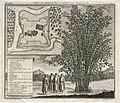 | |
| Fort Jacatra (Nassau and Mauritius) (dismantled between 1627 and 1632)[6] | Fort Jacatra | before 1619[6] | 6°07′43″S 106°48′36″E / 6.128640°S 106.809979°E | — | ||
| Fort Jacarta Buiten Batavia (demolished) | Fort Jacarta Buiten Batavia | anonymous | 6°08′43″S 106°49′50″E / 6.145389°S 106.830442°E | — |  | |
| Fort Meester Cornelis (demolished) | Fort Meester Cornelis | 1734 | anonymous | 6°12′05″S 106°51′00″E / 6.201325°S 106.850101°E |  |  |
| Fort Noordwijk (demolished in 1808) | Fort Noordwijk[8] | 1658 | anonymous | 6°10′04″S 106°49′51″E / 6.167773°S 106.830801°E | — |  |
| Fort Zevenhoek (demolished) | Fort Zevenhoek | 1657[16] | anonymous | — | ||
| Fort Rijswijk (abandoned in 1697, demolished in 1729)[17] | Fort Rijswijk[8] | August 1656[17] | anonymous | 6°10′03″S 106°49′08″E / 6.167574°S 106.818830°E |  |  |
| Galangan VOC Restaurant and Ta San Yen | Carpenter's shop of the Dutch East Indies | 1627–1632[6] or before 1650[7] or 1727[18] | anonymous | 6°07′42″S 106°48′32″E / 6.128344°S 106.808937°E |  |  |
| Gedung Candra Naya (1957)[19] | Landhuis Kroet / Landhuis Van Majoor der Chinezen Khouw Kim An or "residence of Chinese Mayor Khouw Kim An"[20] | 18th century[20] | Khouw Tjoen (first resident)[20] | 6°08′50″S 106°48′55″E / 6.147337°S 106.815284°E |  |  |
| Gerbang Amsterdam or "Amsterdam Gate" (demolished in the 1950s) | Amsterdamsepoort, Pinangpoort, Kasteelpoort | 1744[21] | 6°07′51″S 106°48′43″E / 6.130834°S 106.812062°E |  |  | |
| Gereja Sion | De Portugese Buitenkerk | 1695[14] | E. Ewout Verhagen | 6°08′17″S 106°49′05″E / 6.138009°S 106.817920°E |  |  |
| Gereja Tugu | Portuguese Church | 1676–1678, rebuilt in 1737, and later in 1748. | Melchior Leidecker, later rebuilt by Julius Vinck[22] | 6°07′26″S 106°55′27″E / 6.123844°S 106.924070°E | ||
| Government House or a 'Playhouse' (demolished) | Huis van de Generaal/Speelhuis | 1632-1650[6][7] | anonymous | 6°08′31″S 106°48′55″E / 6.141976°S 106.815156°E | — | |
| Great Palace of Weltevreden (demolished in 1820, now Gatot Soebroto Army Hospital)[23][24] | Great Palace of Weltevreden / Landhuis Weltevreden[24] | 1761[23] | for Jacob Mossel[23][nb 2] | 6°10′36″S 106°50′12″E / 6.176726°S 106.836608°E | — |  |
| Groeneveld (estate) | Tandjoeng Oost Huis, "Gedong Tinggi"[26][27] | 1756–1760[28] | Pieter van de Velde (first owner)[28] | 6°18′10″S 106°51′23″E / 6.302771°S 106.856292°E |  | |
| Jembatan Gantung Kota Intan | Engelse Brug[29] / Het Middelpuntbrug[30] / Grote Boom or "Large Tree Bridge"[30] / Djembatan Hoenderpasser Kali Besar or Hoenderpasserbrug or "Chicken Market Bridge" (1900s)[29][30][31] / Ophaalbrug Juliana (1938)[30] | 1655 (after the demolition of earlier English Bridge, located 100 meter to the south),[6][29] 1937 (renovated)[30] | 6°07′53″S 106°48′38″E / 6.131259°S 106.810579°E |  |  | |
| Kasteel Batavia | Kasteel Batavia | 1619[6] | anonymous | 6°07′40″S 106°48′41″E / 6.127854°S 106.811338°E |  |  |
| Mesjid Luar Batang, Luar Batang Mosque | Mesjid Luar Batang | 1739 (established)[32] | Sayid Husein bin Abubakar Alaydrus (founder)[32] | 6°07′26″S 106°48′24″E / 6.123765°S 106.806533°E |  | |
| Mohr Observatory (demolished in 1812) | Mohr Observatory | 1765 | Johan Maurits Mohr | 6°08′38″S 106°48′46″E / 6.143863°S 106.812911°E |  |  |
| Museum Bahari | Warehouse | 1652–1771 | anonymous | 6°07′36″S 106°48′30″E / 6.126753°S 106.808279°E |  |  |
| Museum Sejarah Jakarta | Batavia City Hall (3rd) | 1706–1710[33] | W.J. van der Velde | 6°08′07″S 106°48′48″E / 6.135348°S 106.813372°E |  |  |
| Nieuwe Hollandse Kerk, "New Church of Holland" (destroyed by earthquake in 1808, Wayang Museum is now on its site) | Nieuwe Hollandse Kerk, Groote Hollandse Kerk | 1736 | 6°08′06″S 106°48′45″E / 6.134882°S 106.812603°E |  | 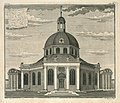 | |
| Nieuwe Poort, "New Gate" (demolished) | Nieuwe Poort | 1627–1632[6] | anonymous | 6°08′18″S 106°48′50″E / 6.138424°S 106.813777°E |  | |
| Old Gelderland defence works (demolished after 1667)[6] | Oud Gelderland | 1622–1627[6] | anonymous | 6°08′06″S 106°48′56″E / 6.135031°S 106.815689°E | — | |
| Oude Hollandse Kerk, "Old Holland Church" (demolished in 1732, bottom part still visible)[nb 3] | Oude Hollandse Kerk / Kruiskerk, "Cross Church" | 1640 | anonymous | 6°08′06″S 106°48′45″E / 6.134882°S 106.812603°E |  |  |
| Oude Utrechtse Poort, "Old Utrecht Gate" (demolished) | Oude Utrechtse Poort[nb 4] | 1632–1650[6] | anonymous | 6°08′10″S 106°48′26″E / 6.136034°S 106.807207°E | — | |
| Pasar Ikan, "Fish Market" | Vismarkt | anonymous |  |  | ||
| Playhouse of Adriaan van Hafte | Playhouse of Adriaan van Hafte | 18th century | anonymous | Tanjung Priok | — | |
| Raja Kuring Restaurant | Carpenter's shop of the Chinese | 1632–1635[6] | anonymous | 6°07′48″S 106°48′35″E / 6.130012°S 106.809692°E[7] | ||
| Spinhuis, "spinning-house for single women" (later merged with Chinese Hospital,[12] then demolished) | Spinhuis, Spinhuys | 1635–1650[6] | anonymous | 6°08′03″S 106°48′30″E / 6.134214°S 106.808318°E | — |  |
| The Latin and Greek School (demolished)[2] | The Latin and Greek School | 1622-1627[6] | anonymous | 6°07′55″S 106°48′48″E / 6.131917°S 106.813228°E[6] | — |  |
| Toko Merah | see Toko Merah | 1730[nb 5] | for Gustaaf Willem van Imhoff | 6°08′09″S 106°48′41″E / 6.135955°S 106.811285°E |  |  |
| Vihara Dharma Bhakti | Kim Tek Ie | 1650, 1755 (restored)[35] | Kwee Hoen (Guo Xun-Gan)[35] | 6°08′38″S 106°48′46″E / 6.143973°S 106.812736°E |  |  |
| Vismarkt, "Fish Market" (earlier structure) (demolished) | Vismarkt, Vischmarkt | 1632–1635[6] | anonymous | 6°07′50″S 106°48′36″E / 6.130653°S 106.80995°E | 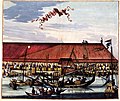 |  |
| Waterkasteel (demolished) | Waterkasteel / "Hornwerk"[36] | 1741, 1750[37] | anonymous | 6°06′58″S 106°48′24″E / 6.116205°S 106.806601°E | — |  |
| Wooden former office building at Kali Besar Timur (abandoned) | Various offices; Chinese shops (early 18th-century)[3] | early 18th-century[3] | anonymous | 6°08′06″S 106°48′43″E / 6.134928°S 106.811904°E |  |  |
Colonialism – late 18th century to 1870
[edit]After the VOC was formally dissolved in 1800 the Batavian Republic expanded all the VOC's territorial claims into a fully fledged colony named the Dutch East Indies. From the company's regional headquarters Batavia now evolved into the capital of the colony. In 1808 Daendels moved the old town center to higher ground to the south and urbanized the area known as Weltevreden. During the British interregnum Daendels was replaced by Raffles who governed until 1816.
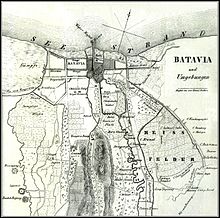
As the Dutch become more securely established in the region, towns grew up beyond the walls of the fort.[2] Batavia, together with Semarang and Ujung Pandang, were the most important urban centers.[2] During this time, Batavia became congested and wealthier merchants and other powerful men began to build their residences on the outskirts of town and in the surrounding countryside.[2]
The period shows a gradual adaptation to the tropical climate form on the part of the Dutch colonial architecture. These new form of architecture is called Indische Stijl. Typical style during this period include large roof overhang, high roof and ceiling, and front and rear verandahs that opened on to gardens. Indies style can be described as a mix of Indonesian, Chinese, and European influence. Very often the local Javanese style limasan roof was employed, but with addition of 19th-century European architectural elements such as Tuscan columns, doors, windows, and a flight of three to four steps leading up to a verandah running the full width of the house.[2]
Neoclassicism was a popular style for buildings in Jakarta during this period, which is considered to be the best representation of the greatness of the empire.[38]
| Last official name | Former names | Year | Architect | Location | Latest image | Oldest image |
|---|---|---|---|---|---|---|
| Aley Cramerus Residence | anonymous | — |  | |||
| C. Schultze Residence | anonymous | — |  | |||
| H. Vaupel Residence | — |  | ||||
| J.J. Kunst Residence | anonymous | — |  | |||
| M.C. Westerman Residence | anonymous | — |  | |||
| W.C. van Benthem Jutting Residence | anonymous | Kebon Sirih, Weltevreden | — |  | ||
| All Saints Church | Engelsekerk, Gereja Inggris (original) / Church of the British Protestant Community (BPC) (1843) / All Saints Church (1950)[39] | 1828[39] | 6°11′00″S 106°50′06″E / 6.18335°S 106.835011°E | |||
| Armenian Church (demolished, now a field within Bank Indonesia Thamrin building) | Armeensche kerk | 1831[40] | 6°10′51″S 106°49′21″E / 6.180893°S 106.822408°E | |||
| Asrama Polisi Sektor Palmerah | Landhuis Kebayoran Lama / Gedung Tinggi or "tall building"[nb 6] / Rumah Grogol or "Grogol house" / Residence of Andreas Hartink | 18th century[41][42] | W.J. Van de Velde[41] | 6°12′26″S 106°47′22″E / 6.207208°S 106.789482°E |  | |
| Balai Kota DKI Jakarta | see Jakarta City Hall | 19th century[43] | anonymous | 6°10′52″S 106°49′44″E / 6.181220°S 106.828964°E |  | |
| Biara Santa Ursula, Kapel, dan Sekolah Santa Ursula; "St Ursula cloister, chapel, and school" | Ursulinen Klooster, "Kleine Klooster"[44] | 1859 (cloister), 1888 (chapel), 1912 (school) | anonymous | 6°10′07″S 106°50′03″E / 6.168618°S 106.834143°E |  |  |
| Café Batavia (1991)[45] | see Café Batavia | 1837[45] | 6°08′04″S 106°48′46″E / 6.134410°S 106.812740°E |  | ||
| Church of Saint Mary Ascend to Heaven (first form) (renovated in 1859) | De Kerk van Onze Lieve Vrouwe ten Hemelopneming (original) | November 6, 1829 (inauguration) | Monseigneur Prinsen (inaugurated) | 6°10′08″S 106°49′59″E / 6.169013°S 106.833114°E | ||
| Church of Saint Mary Ascend to Heaven (second form) (collapsed in 1890) | De Kerk van Onze Lieve Vrouwe ten Hemelopneming (original) | 1859 (renovation of the earlier form) | 6°10′08″S 106°49′59″E / 6.169013°S 106.833114°E | |||
| Citadel Prins Frederik (demolished, on its site stands the Istiqlal Mosque, Jakarta) | Citadel Prins Frederik[5] | 1831[5] | 6°10′13″S 106°49′51″E / 6.170386°S 106.830742°E |  |  | |
| De Club Burger Societeit (demolished) | Residence (1815, 1819) / Hotel Marine (1833)[46] | 1815 | 6°10′03″S 106°49′13″E / 6.167613°S 106.820352°E |  | ||
| Dewan Kerajinan Nasional (February 24, 1992)[47] | Residence / Office of Hamengkubuwono IX (1945)[47] | 1860–1870[47] | anonymous | Jl. Prapatan No. 42 Kel. Senen, Kec. Senen, Jakarta 10410[47] | ||
| Galeri Nasional Indonesia | See National Gallery of Indonesia | 1817 | G.C. van Rijk (commissioner?) | 6°10′43″S 106°50′00″E / 6.178529°S 106.833276°E |  | |
| Gedung A.A. Maramis | Palace of Governor-General Daendels / Het Groote Huis / Het Witte Huis[nb 7] | March 7, 1809[48] | J.C. Schultze, completed by J. Tromp (1828)[48] | 6°10′09″S 106°50′14″E / 6.169257°S 106.837096°E |  |  |
| Gedung Kawedri (1987)[49] | TNI AD Department of Health[50] / TNI Batalyon Kala Hitam headquarter (1949)[50] / Netherlands/Japanese/Allied Civil Defense Department (1942–1949)[50] / Hogere Burger School (1867)[50]/ Gymnasium Koning Willem III School te Batavia (original)[50] | 1860 (school established)[50] | anonymous | 6°11′56″S 106°51′07″E / 6.198758°S 106.85183°E |  |  |
| Gedung Kesenian Jakarta | Stadtsschouwburg / Bataviasch Schouwburg / "Gedung Komidi" / Shintsu Tekijō[51] | 1821[nb 8] | J.C. Schultze | 6°10′00″S 106°50′04″E / 6.166540°S 106.834417°E |  |  |
| Gedung Pancasila, Pancasila Building[52] / Gedung Departemen Luar Negeri or Building of the Ministry of Foreign Affairs[53] | Residence of Hertog Bernhard (original)[52] / residence of Dutch Royal Army Commander / Volksraad or Council of the Indies Building or Raad van Indië (1918) / Dokuritsu Zyunbi Tyoosakai or Badan Penyidik Usaha-Usaha Persiapan Kemerdekaan[53] | 1830[53] | J. Tromp[53] | 6°10′28″S 106°50′01″E / 6.174350°S 106.833632°E |  |  |
| Gereja Immanuel, "Emmanuel Church" | Willemskerk or "Williams Church" | 1835–1839 | J.H. Horst | 6°10′36″S 106°49′55″E / 6.176703°S 106.832081°E |  |  |
| Grand Hôtel Java (Demolished in the 1950s and replaced with Markas besar TNI Angkatan Darat (headquarters of the National Indonesian Army Land Forces))[54] | Private residence (original)[54] / Grand Hôtel Java (1834) | early 19th century | anonymous | 6°10′06″S 106°49′42″E / 6.168221°S 106.828216°E |  |  |
| Hotel des Indes 1st form (renovated in 1930)[55] | a residential / Hotel Chaulan (1828)[nb 9] / Hotel de Provence (1835) / Hotel Rotterdamsch (1854) / Hotel des Indes (May 1, 1856) | 1930 | ? | 6°09′56″S 106°49′11″E / 6.165495°S 106.819806°E |  |  |
| Hotel Dharma Nirmala (demolished and replaced with Bina Graha Presidential Office in 1969)[56] | see Hotel der Nederlanden | 1794[57] | anonymous | 6°10′05″S 106°49′30″E / 6.167956°S 106.824918°E |  |  |
| Hotel Sriwijaya (1950)[58] | Hotel Cavadino (1863) / Hotel Lion d’Or (1899) / Park Hotel (1941)[58] | 1863 | for Conrad Alexander Willem Cavadino | 6°10′08″S 106°49′47″E / 6.168918°S 106.829860°E | ||
| Hotel Wisse (1891, replaced with Hotel des Galeries in 1920) | Residence of Governor-General Petrus Albertus van der Parra / Hotel Ernst (1860–1891)[59] | around 1750 | for Governor-General Petrus Albertus van der Parra | 6°10′01″S 106°49′16″E / 6.166930°S 106.821007°E |  | |
| Istana Merdeka | Governor General's Palace or Paleis van de Gouverneur-Generaal, "Gambir Palace" | 1873 | Drossares | 6°10′13″S 106°49′27″E / 6.170170°S 106.824177°E |  |  |
| Istana Negara (1949) | Residence of Jacob Andries van Braam (original); Schonburg Building; Paleis Z. E. Gouverneur Generaal te Rijswijk | 1796–1804, 1848 (renovated after an earthquake)[60] | ? | 6°10′05″S 106°49′26″E / 6.168084°S 106.823956°E |  |  |
| Sunda Kelapa Lighthouse[61] | Vuurtoren Batavia | 1862 | anonymous | 6°06′18″S 106°48′19″E / 6.105129°S 106.805397°E |  |  |
| Jean Belle Residence (demolished, replaced with Nederlandsche Handels Maatschappij te Weltevreden in 1910)[62] | Jean Belle Residence[62] | anonymous | ||||
| J.P. Coen Statue (demolished on March 7, 1943, during Japanese occupation)[63] | J.P. Coen Statue | 1869[63] | anonymous | 6°10′10″S 106°50′13″E / 6.169353°S 106.836808°E |  |  |
| Kimia Farma at Jalan Budi Utomo | Loge nummer 14: ‘De Ster in het Oosten’;[64] Rathkamp Apotheek (early 20th century);[65] "Gedung Setan"[65] | 1837 (established),[66] 1858? (probably the date of the building)[64] | anonymous | 6°10′04″S 106°50′09″E / 6.167657°S 106.835955°E |  | |
| Kimia Farma at Jalan Veteran | Volksapotheek te Rijswijk[67] | 1857; 1913 (renovated) | anonymous; | 6°10′05″S 106°49′36″E / 6.168194°S 106.826802°E | ||
| Kleedingmagazijn M. De Koning in Noordwijk (Demolished in the 1950s, now Grand Brilliant Palace Restaurant) | Kleedingmagazijn M. De Koning in Noordwijk[68] | anonymous | 6°10′02″S 106°49′39″E / 6.167146°S 106.827491°E | |||
| Magazijn Onderlinge Hulp in Noordwijk (demolished, replaced with Kantor Departemen Keuangan RI bagian KPPN (Kantor Pelayanan Perbendaharaan Negara)) | Magazijn Onderlinge Hulp in Noordwijk[68] | anonymous | 6°10′01″S 106°49′37″E / 6.167054°S 106.827050°E | |||
| Mahkamah Agung or "Indonesia Supreme Court Building" | Hooggerechsgebouw | 1828 | J.C. Schultze, completed by J. Tromp (1828)[48][69] | 6°10′06″S 106°50′12″E / 6.168203°S 106.836664°E |  |  |
| Menara Syahbandar | De Uitkijk | 1839[9] | anonymous | 6°07′39″S 106°48′33″E / 6.127527°S 106.809071°E |  |  |
| Mesjid Jami Kebon Jeruk or "Kebon Jeruk Mosque" | 1786[70] | for Tuan Tschoa (Kapten Tamien Dosol Seeng)[70] | 6°09′20″S 106°49′07″E / 6.155555°S 106.818506°E | |||
| De Militaire School te Meester Cornelis, Military School at Meester Cornelis (closed in 1892, demolished. Now stands the Army Department of Research and Development) | De Militaire School te Meester Cornelis | 1852 (opened) | 6°12′33″S 106°51′36″E / 6.209288°S 106.860127°E |  |  | |
| Military Society Concordia (demolished in the 1960s, now occupied by Gedung A.A. Maramis II Departemen Keuangan) | Military Society Concordia / Kantor Pusar DPR[71] | September 21, 1833 (inauguration); 1836, 1874, 1990 (building extension) | ? | 6°10′13″S 106°50′16″E / 6.170186°S 106.837689°E |  | |
| Museum Nasional, "Museum Gajah" | Bataviaasch Genootschap van Kunsten en Watenschappen, "The Batavian Society of Arts and Science Building"[72] | 1862 | ? | 6°10′35″S 106°49′20″E / 6.176434°S 106.822115°E |  |  |
| Museum Seni Rupa dan Keramik | Palais van Justitie ("Justice Palace") | 1870 | ? | 6°08′04″S 106°48′51″E / 6.134310°S 106.814212°E |  |  |
| Museum Sumpah Pemuda | Customs inspection office / Hotel Hersia (until 1951) / Residence (1937–1951) / Sie Kok Liong's Dormitory for students from outside Java (before 1928)[73] | before 1925 | anonymous |  | ||
| Museum Tekstil (1978) | Residence; Headquarter of Barisan Keamanan Rakyat ("Front of People Safety"); Institution for aged people (1947) | 19th century | anonymous | 6°11′17″S 106°48′35″E / 6.188019°S 106.809620°E |  | |
| Office (building collapsed because of structural failure in 2015, demolished) | NV Koninklijke Boekhandel en Drukkerij G Kolff & Co (1860–1921)[74][75] | Before 1860 | anonymous | 6°08′03″S 106°48′43″E / 6.134228°S 106.811806°E |  |  |
| Oger Frères[76] (demolished, replaced with Singer Building in the 1930s) | Oger Frères | 1823 (store opened) | anonymous | 6°10′05″S 106°49′15″E / 6.168118°S 106.820704°E |  |  |
| Oude Katholieke Kerk, "Old Catholic Church" (demolished in 1830) | before 1821 | anonymous | Weltevreden |  | ||
| Passer Baroe, Pasar Baru | Passer Baroe | 1821[77] | — | 6°09′55″S 106°50′05″E / 6.165375°S 106.834602°E |  |  |
| Percetakan Negara Republik Indonesia, "Indonesian Republic State Printing" ()[78] | Landsdrukkerij (original); Gunseikanbu Inatsu Kojo or GIK (1942–1945); Percetakan Republik Indonesia (1950) | anonymous | 6°11′26″S 106°51′23″E / 6.190694°S 106.856492°E |  |  | |
| Perpustakaan Nasional Indonesia at Jalan Medan Merdeka Selatan | 6°10′52″S 106°49′37″E / 6.1811°S 106.826916°E |  | ||||
| Photographisch Atelier Walter Woodbury (demolished, replaced by Gedung Bina Graha) | Residence of Van Dorp (original) / Photographisch Atelier Walter Woodbury (1861–1908)[79] | before 1861 | anonymous | 6°10′04″S 106°49′31″E / 6.167701°S 106.825144°E |  |  |
| Post- en Telegraafkantoor te Weltevreden | Post- en Telegraafkantoor te Weltevreden | before 1880 | anonymous | Postweg (now Jalan Pos) |  |  |
| Postkantoor Weltevreden (demolished and replaced with a new building in 1913) | Postkantoor Weltevreden | 1853 | anonymous | |||
| Rumah Cililitan Besar (deteriorated and occupied by squatters by the 90's, now made into shanty homes) | Landhuis Tjililitan | 1775 | Hendrik van der Crap (owner) | 6°16′08″S 106°52′15″E / 6.268915°S 106.87073°E |  |  |
| Rumah Sakit Cikini or "Cikini hospital" | Raden Saleh Residence (original); Hospital and a Nurse Academy (1898)[80] | 1852 | Raden Saleh | 6°11′28″S 106°50′28″E / 6.191153°S 106.841235°E |  |  |
| SKAHA (first floor) | Assurantiekantoor Langeveldt – Schröder; Goedang Kakaco (Kerkhoff, Kerstholt & Co., Importeurs)[3] | 19th century? | anonymous | 6°08′12″S 106°48′44″E / 6.136590°S 106.812355°E |  |  |
| SMK Santa Maria | Groote Klooster[44] / Mater Dei (1920)[81] | 1856[81] | anonymous | |||
| Societeit Harmonie or "Harmony Society (Batavia, Dutch East Indies)" (demolished for road widening and parking area in 1985)[82] | Societeit Harmonie | January 18, 1815[nb 10] | J.C. Schultze | 6°10′05″S 106°49′16″E / 6.167927°S 106.821246°E |  |  |
| Stadsherberg (demolished after 1949) | Stadsherberg | 1849 | anonymous | 6°07′30″S 106°48′35″E / 6.125009°S 106.809779°E |  |  |
| Topografische Dienst te Weltevreden | Topografische Dienst te Weltevreden | anonymous |  | |||
| Villa Nova | Villa Nova | Before 1870[83] | anonymous | |||
| Wilhelmina Exposition Pavilion (demolished) | Wilhelmina Exposition Pavilion, Wilhelminapaviljoen | before 1880 | anonymous | 6°10′12″S 106°50′13″E / 6.170018°S 106.836928°E |  |  |
| Zoological and Plant Society Main Building (demolished) | Zoological and Plant Society Main Building |  |
Post Cultuurstelsel abolition – 1870 to mid 20th century
[edit]
The abolition of the Cultuurstelsel in 1870 made way for the rapid development of private enterprises in the Dutch Indies. Numerous trading companies and financial institutions established themselves in Java, most of them settled in Batavia. Jakarta Old Town's deteriorating structures were replaced with offices, typically along the Kali Besar. These private companies owned or managed plantations, oil fields, and mines. Railway stations were designed during this period, with characteristic style of this period.[2]
Architecturally, neoclassicism fell out of favor to be replaced by Neogothic and Dutch Rationalism. Apparent architectural style were Nieuwe Kunst (e.g. Bank Tabungan Negara), Art Deco or De Stijl, and Amsterdam School. This architecture styles were also the tropical counterpart of the original style, resulting in a style called New Indies Style.
Two dominant architectural bureaus during this period were AIA Bureau (Frans Ghijsels) and AA Fermont and Cuypers Bureau (Eduard Cuypers).[2]
Colonnades are required during this period to provide protection against monsoon rains and tropical sun, which in turn transformed the appearance of buildings in the city centers.[2]
Colonial style in Jakarta lingered some years after the Japanese occupation of Indonesia in 1942, and further after the independence of Indonesia in 1945.
| Last official name | Former names | Year | Architect | Location | Latest image | Oldest image |
|---|---|---|---|---|---|---|
| Bioscoop Manggarai or "Manggarai Cinema" | ||||||
| Binnacle (Schakelhuis) |  | |||||
| Frans Consulaat Koningsplein |  | |||||
| Electrification of the State Railway Company at Meester Cornelis (Electrificatie van de Staatsspoor- en Tramwegen (SS en T) bij het spoorwegstation te Meester Cornelis) | 6°07′42″S 106°50′45″E / 6.128221°S 106.845938°E |  | ||||
| Modernist villas of Westerpark | 1920-1930s |  | ||||
| Van Arcken and Co. Shop |  | |||||
| Algemeen Delisch Emigratie Kantoor (A.D.E.K.), "General Deli Emigration Office" (demolished, now Inkoppol) | Algemeen Delisch Emigratie Kantoor; internment camp ADEK(1942–1944); Bunsho I Kamp 8 (1944–1945); Relief camp (1945–1946)[84] | 1920s? | anonymous | 6°12′14″S 106°50′55″E / 6.203975°S 106.848706°E |  | |
| Aquarium, Akuarium | Aquarium: Het Instituut voor de Zeevisserij (Dept. v. Econ. Z.) en het Kantoor voor de Prauwvaartaangelegenheden (Dept. v. Econ. Z.).[3] | 6°07′33″S 106°48′31″E / 6.125700°S 106.808691°E |  |  | ||
| Artesian well at Batoe Toelis (demolished) | Artesian well at Batoe Toelis |  | ||||
| Artesian well at Koningsplein (demolished) | Artesian well at Koningsplein | 6°10′18″S 106°49′32″E / 6.171693°S 106.825636°E[85] |  |  | ||
| Artesian well at Meester Cornelis (demolished) | Artesian well at Meester Cornelis | 1881 | Meester Cornelis |  | ||
| Artesian well at Postweg (demolished) | Artesian well at Postweg |  | ||||
| Artesian well at Salemba (Demolished) | Artesian well at Salemba | 6°11′37″S 106°51′00″E / 6.193574°S 106.849935°E[85] |  | |||
| Asuransi Jasa Indonesia | West Java Handel Maatschappij[86] | 1920[87] | Eduard Cuypers, Hulswit-Fermont | 6°08′03″S 106°48′46″E / 6.134176°S 106.812882°E |  |  |
| Asuransi Jasa Indonesia | De Nederlanden van 1845 (original)[88][89] | 1913[88][89] | Hendrik Petrus Berlage[88] | 6°08′12″S 106°48′48″E / 6.136561°S 106.813296°E | ||
| Asuransi Jiwasraya (1957, original front facade has been demolished for road widening. In 2016, the original front facade was recreated.)[90] | Nillmij | 1909–1910[91] | P.A.J. Moojen and S. Snuyf[91] | 6°10′01″S 106°49′24″E / 6.166923°S 106.823224°E |  | |
| Asuransi Wahana Tata, Wahana Tata Insurance | Office | 19th century[92] | unknown | 6°08′06″S 106°48′40″E / 6.134973°S 106.811088°E |  | |
| Badan Pengawas Tenaga Nuklir (BAPETEN), "Nuclear Energy Regulatory Agency" | Gebouw van Burgerlijke Openbare Werken,[93] Department of Public Works[94] | before 1920[94] | 6°09′50″S 106°49′11″E / 6.163912°S 106.819607°E |  | ||
| Bahtera Jaya Ancol | Jachtclub Tandjong Priok[95] / Koninklijke Bataviasche Jachtclub / Kodja Bataviasche Yacht Club / Badan Keamanan Rakyat Laut headquarter[96] | 1926[97][95] | anonymous | 6°06′44″S 106°51′50″E / 6.11211°S 106.863767°E |  |  |
| Bank Mandiri – Jakarta Pintu Besar | Nederlandsch Indische Escompto-Maatschappij te Javabankstraat (1920) / Escomptobank NV (June 30, 1949)[98] / Bank Dagang Negara (1960) | 1920[99]-1921[100] | Eduard Cuypers, Hulswit-Fermont;[99]Van den Berg en Pichel[3] | 6°08′11″S 106°48′46″E / 6.136417°S 106.812845°E |  |  |
| Bank Mandiri | Nederlandsch Indische Escompto Maatschappij te Noordwijk | 1924[101] | Hulswit-Fermont en Eduard Cuypers [101] | 6°10′00″S 106°49′32″E / 6.166780°S 106.825435°E |  | |
| Bank Mandiri | Chartered Bank of India, Australia, and China / Bank Umum Negara (1965)[102] / Bank Bumi Daya (1968)[102] | 1920[99]-February 27, 1921[102] | Eduard Cuypers, M.J. Hulswit | 6°08′12″S 106°48′41″E / 6.136532°S 106.811417°E |  |  |
| Bank Mandiri – Jakarta-Kota branch | Bank Export Import / Bank Bumi Daya (1960) / Nederlandsch-Indische Handelsbank, Binnen Nieuwpoortstraat (1940) | April 1937 (start), May 25, 1940 (opened)[103] | Wolff Schoemaker, assistant architect Ir. J.F.L. Blankenberg[99][104] | 6°08′13″S 106°48′49″E / 6.137011°S 106.813704°E |  | |
| Bank Sinarmas | NV. Handelsvereniging / NV. Reiss & Co[105] | 1914 | Eduard Cuypers, M.J. Hulswit | 6°08′09″S 106°48′41″E / 6.135787°S 106.811279°E | 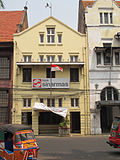 |  |
| Bank Tabungan Negara Office (1968)[106] | Kantoor van de Postspaarbank (1920)[106] / Chokin Kyoku (1942)[106] / Bank Tabungan Pos (1945)[107] | 1920, 1936 (renovated to current form)[106] | RLA Schoenmaker (1920), J. van Gendt (1936)[106] | 6°10′02″S 106°49′13″E / 6.167185°S 106.820338°E |  |  |
| Banteng Building – Kantor Advokat dan Pengacara | N.V. Gebr. Sutorius & Co. Handel Maatschappij (before 1932)[3] | 19th century[3][108] | anonymous | 6°08′10″S 106°48′41″E / 6.136108°S 106.811337°E |  | |
| Bappenas or "Board of National Planning and Development" | Loge "Adhuc Stat",[66][109] 1858? (probably the date of the building)[64] | 1925[109][110] | Frans Ghijsels (AIA Bureau)[110] | 6°12′02″S 106°49′57″E / 6.200663°S 106.832426°E | ||
| Bengkel Praktek Kerja Pendidikan Teknik (1974)[111] | Nederlandsch Indie Gas Maatschappij | 1924 | Jl. Budi Utomo No. 3 Kel. Pasar Baru Kec. Sawah Besar Jakarta 10710 | |||
| Bhanda Graha Reksa | Offices administratiekantoor Tiedeman & van Kerchem and associated firms [nb 11] | 1922–1923[3] | L.M. van den Berg & J.J. Groenema[3][113] | 6°08′10″S 106°48′44″E / 6.136135°S 106.812264°E |  |  |
| Bioscoop Menteng (demolished in 1988, on its site stands Menteng Plaza)[114] | Bioscoop Menteng | 1949[114]-1950 (opened)[115] | Han Groenewegen (Selle, De Bruyn, Reyerse & de Vries)[114] | 6°11′00″S 106°50′03″E / 6.183443°S 106.834165°E |  | |
| BP7 | Volksraad or Council of the Indies Building or Raad van Indië (1918) / Dokuritsu Junbi Chōsakai or Badan Penyidik Usaha-Usaha Persiapan Kemerdekaan[38] | 1927[116] | E. Kühr[116][117] | 6°10′31″S 106°49′59″E / 6.175200°S 106.833073°E |  |  |
| Building at Jl. Kunir no. 2[118] | Geo. Wehry & Co Office building | 1925–1928[3] | A.I.A[3][119] | 6°07′57″S 106°48′53″E / 6.132514°S 106.814826°E |  |  |
| Canisius College | Canisius College AMS | 1927 Opening January 11, 1930[120] | Fermont-Cuypers [121] | 6°11′09″S 106°50′03″E / 6.185809°S 106.834284°E |  | |
| Carl Schlieper Gebouw (destroyed by fire on December 17, 1920, on its site was built de Factorij) | Carl Schlieper Gebouw | 1911[122] | M.J. Hulswit | 6°08′17″S 106°48′47″E / 6.138170°S 106.813085°E |  | |
| Cipta Niaga | Zee en Brand Assurantie[123] / Gebouw van de Internationale Credit en Handelsvereeniging Rotterdam[124] / Tjipta Niaga / Perusahaan Negara Aneka Niaga (ca. 1964)[125] | May 25, 1912[123][124] | Eduard Cuypers, Hulswit[123] | 6°08′04″S 106°48′43″E / 6.134519°S 106.811900°E |  |  |
| Departemen Energi dan Sumber Daya Mineral, "Department of Energy and Mineral Resources" | Batavia Police Headquarter[126] | 1925 (approximate)[126] | 6°10′53″S 106°49′25″E / 6.181321°S 106.823529°E | |||
| Département Keuangan, "Department of Monetary" | Ika-Daigaku Dormitory[127] | 1942[127] | Jl. Prapatan No. 10, Kel. Senen, Kec. Senen, Jakarta 10410 | |||
| Departemen Pertahanan dan Keamanan, "Department of Defense and Security" (1964)[128] | Rechts Hoge School[128] | 1924[128] | J.F. van Hoytema[128] | 6°10′38″S 106°49′19″E / 6.177091°S 106.821867°E | ||
| Djakarta Lloyd Office (abandoned)[129] | Asurantie Kantoor van Ongevallen verzekering mij FATUM en Onderlinge elvensverzekering van EIGEN HULP / Honda (2004)[130] | 1890 | 6°08′03″S 106°48′45″E / 6.134077°S 106.812596°E |  |  | |
| Eigen Hulp aan de Molenvliet West (replaced with Postspaarbank office in 1920)[106] | Eigen Hulp aan de Molenvliet West | 1897[106] | 6°10′02″S 106°49′13″E / 6.167185°S 106.820338°E |  | ||
| Fakultas Kedokteran Universitas Indonesia, "Medical Faculty of the University of Indonesia" | de Geneeskundige Hoogeschool, "Medical College"[131] / School Tot Opleiding Van Inlandse Artsen (STOVIA)[110] | 1919–1926[131] | Dienst B.O.W./H. von Essen[110] | 6°11′42″S 106°50′56″E / 6.194962°S 106.848907°E |  |  |
| Filateli Jakarta | Main Post and Telegraph Office | 1913[132] new front 1921 [133] | J.F. van Hoytema[132] | 6°10′02″S 106°50′02″E / 6.167137°S 106.833818°E |  |  |
| Former office of Nederlandsch Indische Handelsbank (NIHB) | First office of Nederlandsch Indische Handelsbank (NIHB) | 6°07′59″S 106°48′38″E / 6.133186°S 106.810616°E |  |  | ||
| Galeri Melaka, PT Perusahaan Perdagangan Indonesia | N.V. Trading Company Deli – Aceh; Previously Borneo Company | 1923 | Eduard Cuypers and Hulswit | 6°08′13″S 106°48′37″E / 6.137014°S 106.810401°E |  |  |
| Galeri Nasional Indonesia, Gedung B | Bataviaasch Lyceum (See National Gallery of Indonesia) | 1914[134] | M.J. Hulswit [135] | 6°10′41″S 106°49′58″E / 6.178118°S 106.832667°E |  | |
| Gebouw van de Koninklijke Paketvaart-Maatschappij (KPM) bij de Sluisbrug (Demolished for road widening) | Gebouw van de Koninklijke Paketvaart-Maatschappij (KPM) bij de Sluisbrug | 1888 | anonymous | 6°10′04″S 106°49′53″E / 6.167754°S 106.831296°E |  | |
| GKI Kwitang | Gereformeerde Kerk Kwitang | 1924[136] | J. Abell, W.F. Pichel[136] | 6°10′53″S 106°50′19″E / 6.181490°S 106.838501°E | ||
| HAKA Restaurant | Bataviaasch Nieuwsblad newspaper | 1927[137] | Frans Ghijsels | 6°09′56″S 106°49′54″E / 6.165510°S 106.831629°E |  | |
| Kementerian Dalam Negeri, The Ministry of Home Affairs (demolished after 1960) | Binnenlands Bestuur | 1912–1915[132] | J.F. van Hoytema[132] | 6°10′09″S 106°49′42″E / 6.169078°S 106.828342°E | ||
| Kementerian Koordinator Bidang Pembangunan Manusia dan Kebudayaan Republik Indonesia, Coordinating Ministry for Human Development and Culture of the Republic of Indonesia | Passagekantoor van de Rotterdamse Lloyd en de Stoomvaart Maatschappij Nederland[138] | 1930[139] | Fermont-Cuypers | 6°10′20″S 106°49′21″E / 6.172329°S 106.822381°E | ||
| Koperasi Jiwasraya | Der Levensverzekering Mij. Dordrecht te Weltevreden[140] | 1913[140] | Ed. Cuypers & Hulswit te Weltevreden[140] | 6°10′02″S 106°49′18″E / 6.167095°S 106.821572°E | ||
| Gereja Katedral Jakarta (final form) | De Kerk van Onze Lieve Vrowe ten Hemelopneming (original) | 1901 | Antonius Dijkmans, MJ Hulswit | 6°10′08″S 106°49′59″E / 6.169013°S 106.833114°E |  |  |
| Gereja Koinonia | GPIB Bethel Jemaat Djatinegara (1961) / Bethelkerk (original)[141] | March 28, 1889[141] | 6°12′50″S 106°51′43″E / 6.213764°S 106.861818°E |  | ||
| Gereja Pniel (1953) | "Gereja Ayam" ("Chicken Church") / Haantjes Kerk[142] | 1913–1915 (replacing earlier church built in 1850) | Eduard Cuypers, Hulswit-Fermont[143] | 6°09′39″S 106°50′03″E / 6.160909°S 106.834265°E |  | |
| Gereja St Paulus (October 31, 1948) | See St. Paul's Church, Jakarta | 1936[144] | Frans Ghijsels (AIA Bureau)[144] | 6°12′02″S 106°49′53″E / 6.200499°S 106.831460°E |  |  |
| Gereja St Yoseph Matraman, "St. Joseph's Church" | St. Joseph Church Matraman | 1906 – June 22, 1909[145] or 1924[146] | Frans Ghijsels (AIA Bureau);[146] Ir Erawan Kartawidjaja (renovation in 2001) | 6°12′30″S 106°51′35″E / 6.208243°S 106.859596°E |  |  |
| Gereja St Theresia, "St. Theresia's Church" | Theresiakerk | 1934[147] | J.Th. van Oyen[147] | 6°11′20″S 106°49′32″E / 6.188929°S 106.825490°E |  |  |
| GKI Pinangsia, "Pinangsia Church" | Geredja Keristen Tionghoa | April 11, 1952 (opening)[148] | 6°08′27″S 106°48′59″E / 6.140808°S 106.816266°E |  | ||
| Pasar Glodok main building | Hoofdgebouw Pasar Glodok | 1920[149] | B.J.K. Cramer[149] | 6°08′35″S 106°48′52″E / 6.142926°S 106.814401°E |  | |
| Hotel Duta Indonesia (demolished in 1972, replaced with Duta Merlin Plaza)[55] | Hotel des Indes | 1930 | Burhoven Jaspers[55] | 6°09′56″S 106°49′11″E / 6.165495°S 106.819806°E |  |  |
| Hotel Melati | Hotel des Galeries | 1914 | anonymous | 6°10′01″S 106°49′16″E / 6.166930°S 106.821007°E |  | |
| Jasa Raharja | Zee en Brand Verzekerings Maatschapij Sluyters & Co / Assurantiekantoor Blom & Van der Aa, Assurantiekantoor Combinatie Sluyters & Co, and de Java-China-Japan Lijn.[3] / Lloyd Insurance (1950)[150] | around 1911[3] | anonymous | 6°08′08″S 106°48′44″E / 6.135694°S 106.812086°E |  |  |
| Kantor Pelayanan Pajak Jakarta Tambora, "Tambora Tax Office" | HSBC[105] | 1910–1911[3] | Following plan of Eduard Cuypers and Hulswit | 6°08′08″S 106°48′40″E / 6.135680°S 106.811241°E |  |  |
| Kantor Pos Cikini, "Cikini Post Office" | Tjikini post kantoor | Before the 1920s | anonymous | 6°11′14″S 106°50′12″E / 6.187273°S 106.836711°E |  |  |
| Kantor Pos Kota, "Kota Post Office" | Post- en telegraaf kantoor aan het Stadhuisplein | 1929[110] | R. Baumgartner[110] | 6°08′02″S 106°48′48″E / 6.134022°S 106.813279°E |  |  |
| Kerta Niaga (1966)[151] | MUCH: Maatschappij voor Uitvoer en Commissiehandel | 1915[152] | Eduard Cuypers and Hulswit[3] | 6°08′09″S 106°48′44″E / 6.135830°S 106.812145°E |  |  |
| Komite Nasional Keselamatan Transportasi – Departemen Perhubungan, "National Committee on Sea Transportation Safety, Ministry of Transportation" | Koninklijke Paketvaart-Maatschappij (original) / Japanese Marine Department (1942) | 1916–1918[153] | Frans Ghijsels (AIA Bureau)[153] | 6°10′30″S 106°49′51″E / 6.174917°S 106.830969°E |  |  |
| Kunstkring Art Gallery | Bataviasche Kunstkring. see Kunstkring Art Gallery | 1913 | P.A.J. Moojen | 6°11′20″S 106°50′01″E / 6.188898°S 106.833497°E |  |  |
| Lembaga Biologi Molekul Eijkman, Eijkman Institute for Molecular Biology[154] | Eijkman Instituut | 1914 (built), 1916 (inauguration)[155] | H von Essen[155] | 6°11′53″S 106°50′47″E / 6.198011°S 106.846399°E | 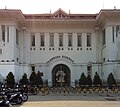 |  |
| Lembaga Pendidikan Jurnalistik Antara, "Antara Institute of Journalism" | see Gedung Antara | 1920 [156] | Reyerse & De Vries | 6°09′57″S 106°50′02″E / 6.165816°S 106.833924°E |  |  |
| Mesjid Cut Mutiah (1987) | N.V. de Bouwploeg (original) / post office, Train Company (1942–1945) / office of Home and Religion (1964–1970). | 1922 | P.A.J. Moojen | 6°11′14″S 106°50′00″E / 6.187285°S 106.833358°E |  |  |
| Metropole | Bioscoop Metropol / Megaria | 1932 | Liauw Goan Sing | 6°12′00″S 106°50′37″E / 6.200059°S 106.843688°E |  |  |
| Michiels Monument (demolished between 1942 and 1945)[157] | Michiels Monument | mid 19th century | 6°10′16″S 106°50′00″E / 6.171074°S 106.833451°E |  |  | |
| Monument voor de Slag bij Waterloo (demolished) | Monument voor de Slag bij Waterloo |  | ||||
| Monument for J.B. van Heutsz (demolished in 1960) | Monument for J.B. van Heutsz | 1927–1932[158] | 6°11′13″S 106°50′03″E / 6.186994°S 106.834119°E |  |  | |
| Museum Joang '45 (1975)[159] | Hotel Schomper[159] / Ganseikanbu Sendenbu (1942–1945) / Asrama Angkatan Baroe Indonesia / Gedung Menteng 31 | 1920s[159] | 6°11′10″S 106°50′12″E / 6.186098°S 106.836601°E |  | ||
| Museum Kebangkitan Nasional, "Museum of the History of National Awakening" | STOVIA[131] | 1899–1902[131] | 6°10′43″S 106°50′17″E / 6.178718°S 106.838034°E |  | ||
| Museum Bank Indonesia | De Javasche Bank | 1909, extensions 1924–1928 / new frontbuilding 1937 | Eduard Cuypers and M.J. Hulswit / Fermont-Cuypers | 6°08′14″S 106°48′46″E / 6.137185°S 106.812856°E |  |  |
| Museum Bank Mandiri | See Bank Mandiri Museum | 1932[160] | J.J. de Bruyn, A.P. Smits and C. van der Linde[160] | 6°08′17″S 106°48′47″E / 6.138170°S 106.813085°E |  |  |
| Museum Sasmita Loka Ahmad Yani | residence of Ahmad Yani / residence | 1930[161] | 6°12′16″S 106°50′11″E / 6.204564°S 106.836524°E |  | ||
| Museum Taman Prasasti | Europese Kerkhof | 6°10′20″S 106°49′08″E / 6.172196°S 106.818946°E |  |  | ||
| Museum Wayang | Museum of Old Batavia (1939) / Geo Wehry & Co Warehouse | 1912[2] | 6°08′06″S 106°48′45″E / 6.134882°S 106.812603°E |  |  | |
| Nederlandsche Handels Maatschappij te 22 Noordwijk (Demolished in 1984, replaced with Kantor Departemen Keuangan RI bagian KPPN (Kantor Pelayanan Perbendaharaan Negara))[62] | Nederlandsche Handels Maatschappij te 22 Noordwijk / "Factorij"[62] | 1910 | Eduard Cuypers M.J.Hulswit | 6°10′01″S 106°49′39″E / 6.167017°S 106.827407°E |  | 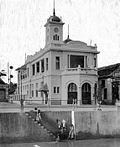 |
| Office building at Jl. Taman Fatahillah no. 2 | Gebouw West Java (WEVA) | 1920[162] | Eduard Cuypers and Hulswit-Fermont | Jl. Taman Fatahillah No. 2 Kel. Penjaringan, Kec. Taman Sari Jakarta Barat | ||
| Old City Club | Het Nieuws van den Dag (original) / Asuransi Ikrar Lloyd / Athena Discothèque | 1925–1927[163] | Reyerse de Vries architecten- en ingeniersbedrijf[163] / Ir. W. Selle | 6°08′07″S 106°48′40″E / 6.135152°S 106.811078°E |  | |
| Oranje Brouwerij (demolished, now Kompleks Rukan Puri DeltaMas Bandengan) | Archipel Brouwerij[164] | Before 1939 | 6°08′16″S 6°47′57″E / 6.137692°S 06.799093°E |  | ||
| Pancoran Tea House[165] | Apotheek Chung Hwa[165] | 1928[165] | unknown; PT Pembangunan Kota Tua Jakarta (JOTRC) and Jakarta Endowment for Arts & Heritage (JEFORAH) (restoration and alteration in 2015) | 6°08′32″S 106°48′53″E / 6.142221°S 106.814604°E | ||
| Pasar Gambir Market Structures/Pavilions (demolished) | Pasar Gambir Market Structures/Pavilions | 6°10′44″S 106°49′33″E / 6.178931°S 106.825833°E |  | |||
| Pasar Ikan | Pasar Ikan, Gemeentelijke vismarkt | 1926[3] | H.A. Bond & R.A. Ogilvie[3] | 6°07′35″S 106°48′32″E / 6.126295°S 106.808886°E |  |  |
| Pelayaran Bahtera Adhiguna | The Ships Agency Ltd Office | 19th century[166] | 6°08′08″S 106°48′44″E / 6.135544°S 106.812098°E |  | ||
| Pertamina headquarter (1957), front section is rented to Bank Mandiri.[167] | Batavia Petroleum Maatschappij (original)[167] / Japanese Military Headquarter[167] / General Staff of the Army (before 1950)[167] | 1937–1938[168] | Fermont-Cuypers, Th.C. Nix[168] | 6°10′22″S 106°49′51″E / 6.172885°S 106.830722°E | 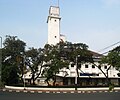 |  |
| Perusahaan Listrik Negara, State Electricity Company | Kantoor van Nederlandsch Indie Gas Maatschappij (1897)[169] | 1897 | 6°10′50″S 106°49′58″E / 6.180478°S 106.832777°E | |||
| Rathkamp and Co. Pharmacy (demolished after 1948) | Rathkamp and Co. Pharmacy | 1912 | Eduard Cuypers, Hulswit-Fermont | 6°10′08″S 106°49′16″E / 6.168837°S 106.821009°E |  |  |
| Rumah Sakit PELNI Petamburan, "PELNI Petamburan Hospital" | KPM Petamboeran Hospital[170] | 1914–1915, 1920 (extension) | Frans Ghijsels | 6°11′35″S 106°48′13″E / 6.193155°S 106.803531°E |  | |
| Rumah Sakit Umum Dr. Cipto Mangunkusumo, "Cipto Mangunkusumo General Hospital" | Medicinal warehouse for the Ministry of Health of the Dutch Colonial Government / Teaching Hospital (1919) / Het Centrale Burgerlijke Hospitaal (CBZ) or "Central Civil Hospital of Batavia" / Ika-daigaku Byōin (1942–1945)[171] | 1919–1926[171] | 6°11′50″S 106°50′51″E / 6.197111°S 106.847549°E |  |  | |
| Samudera Indonesia Commercial Fleet Division (Breakbulk & NVOCC) office building[172] | Maintz & Co Office[172] | 1920s[172] | F.J.L. Ghijsels[172] | 6°07′59″S 106°48′38″E / 6.132948°S 106.810554°E | ||
| Nitour Building[173] | Singer and Nitour Travel Agency Building (early 1950s)[174] | 1938[174] | Fermont-Cuypers[175] | 6°10′05″S 106°49′15″E / 6.168118°S 106.820704°E |  |  |
| SMK Santa Maria | Koningin Emma School[81] | 20th century[81] |  | |||
| St. Aloysius Broederschool (demolished, on its site stands carpark of Pertamina Headquarter) | St. Aloysius Broederschool[176] | 1908 (construction) | P.A.J. Moojen[177] | 6°10′24″S 106°49′51″E / 6.173346°S 106.830867°E |  |  |
| Stasiun Jatinegara | Station Meester Cornelis | 1910[178] | S. Snuyff[178] | 6°12′55″S
|